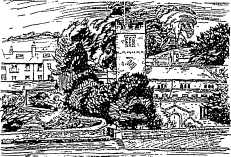| JOURNAL 1993 |
| North Craven Heritage Trust |
On the previous evening, while giving the weather forecast, the met. man on the television almost broke down and wept at the thought of storms to come. In fact, it was cloudy bright, with a little morning precipitation to settle the dust and a hefty shower falling on a parched earth when we were undercover. Our expedition was to the Upper Lune. The Howgills—Sedbergh's "naked heights" (Wordsworth)—were in clear view.
Three architectural attractions were Middleton Hall (home of the Middleton family from the mid- 14th to the late 17th centuries), Brigflatts (one of the oldest of the Friends' Meeting Houses) and Sedbergh School Chapel (High Victorianism, having been built in 1897).
Middleton Hall hides behind an ancient 18 ft wall. A member on traffic duty at the roadside managed to wave into the approach road all our party, plus a car containing some bemused holiday makers. A welcome was given by Hazel Watson, the farmer's wife, who allowed us access to the principal rooms, where Muriel Humphries told a fascinating fable about the Redmaynes and the Middletons—a tale ending with a priest being called to exorcise the ghost of a woman who, in fact, was his mother, a nun! The story would be a sensation if presented on television.
I read the story of the sheep-clipping at Middleton Hall in 1879 when 2,000 sheep and 1,000 lambs were gathered by 13 men and a dog and almost 100 clippers clipped the sows with time left for feasting, sports and dancing till the "wee small hours".
The party then dispersed in Sedbergh, on market day, and reassembled in the early afternoon near Brigflatts. A dozen cars were parked in a glorified lay-by and more inched into the spaces down the lane to the Meeting House, where Melville, the warden, wearing a straw hat, welcomed us. The garden and road verges were multicoloured with summer blooms, pheasants were tending their chicks in the burial ground and the local farmer greeted our arrival with a march past of sheep which returned, having been dipped, shortly afterwards.
The only crisis to arise was when to have tea and biscuits—before or after the talk—and eventually this was resolved and we began with feasting. The members sat on the old wooden forms in the 300-year-old building and heard about George Fox and the beginnings of Quakerism. Some members had driven up to Fox's "Pulpit" on Firbank Fell.
Thence to Sedbergh School Chapel, designed by the Lancaster firm of Austin and Paley and completed in 1897, replacing a wooden hut. Prior to this, the boys had worshipped in the old parish church. The Chapel looked very ordinary on the outside but inside was an assertion of Victorian religious certainties, with some fine needlework at the altar and lots of fascinating memorial plaques to scrutinise.
Some members, with energy left, went on the "optional extra"—to Pennine Tweeds, in an old mill on the outskirts of Sedbergh, where Dobcross looms are used in hand-weaving and bolts of cloth testified to the skills of the weavers.

J1993p10_20_files/tmpBB9-15.jpg
Sedbergh Church